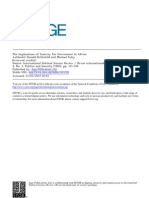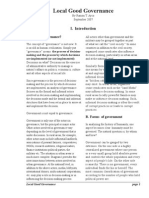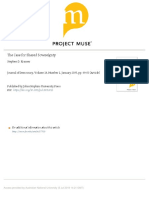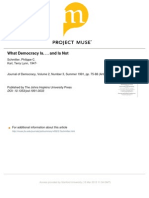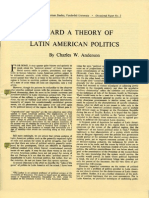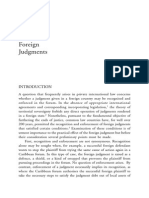70 Governance, Administration and Development The Policy Process 71
70 Governance, Administration and Development The Policy Process 71
Uploaded by
Afia IsmailCopyright:
Available Formats
70 Governance, Administration and Development The Policy Process 71
70 Governance, Administration and Development The Policy Process 71
Uploaded by
Afia IsmailOriginal Title
Copyright
Available Formats
Share this document
Did you find this document useful?
Is this content inappropriate?
Copyright:
Available Formats
70 Governance, Administration and Development The Policy Process 71
70 Governance, Administration and Development The Policy Process 71
Uploaded by
Afia IsmailCopyright:
Available Formats
7 0 Governance, Administration and Development them' (Grindle and Thomas, 1989, p. 220).
It has even been evident in some neo-Marxist literature where the state demonstrates relative autonomy in making decisions against the expressed interests of the . dominant classes. The state is seen to have interests - or to avoid reification, off- als of the state identify and pursue collective interests because of their shared location in the state. These state interests can refer to any aspect of human activity ranging from defence of the state t, 7, attempts to change public morals. Different states can be seen as having different degrees of autonomy and perhaps different interests vis-a vu those of societal actors. The great strength of this approach is that although its analytical focus is the state, the nature of state-society relations is also of concern as this will determine the degree of autonomy of policy elites in the state. As Nordlinger (1987, p. 386) notes, `Taking the state seriously involves bringing statist 'and societal accounts of state autonomy together in empirically meaningful, mutually illuminating, and ana lytically integrated ways'. We will pursue one of these ways in the next section where we make deeper investigations of who actually participates in policy-making and who does not.
The Policy Process 71 demonstrated little tolerance of dissent over his policies. In some instances, such as Idi Amin in Uganda, it is not even possible to talk of a policy circle as the extreme unpredic tabi lity of life and arbitrariness"of decision-making render the notion of policy obsolete. As in much of the de\ e'.oping world the regimes of sub-Saharan Africa have frequently been authoritarian in character. Such regimes I,} definition restrict decision-making to relatively few individuals and groups. Democratic forms such as parliaments and congresses are typically closed or shorn :), lws\er, regime opponents may be im prisoned, the media are tigh tly controlled and mobilization of the population is at the hrhcst >f the state. While personal rulers such as Banda, Marcos and Somcza feature prominently in authoritarian regimes there are in fact outer significant actors in the policy circle. The most obvious of these actors is the military. In Latin America, for example, military ; ntcr , cation in politics and prolonged military rule have been common. Contemporary Latin American armies are professionalized, self-conscious and hierarchically organized forces which began to intervene it politics in response to economic collapse and perceived civilian incoo:petence in the 1920s and 1930s (C am mack et al., 1988). They i ; ve ruled for considerable periods, espe cially in the more developed countries on the continent, and even when not in office have exerted considerable influence on policy making. In the Middle East. the military has played a `decisive role'. Since, 1958, the monarchic, of Iraq, Egypt and Libya have fallen to officer-led initiatives while ;,onlemporary Syrian politics focuses on factional shifts within the military. Middle Eastern military regimes have sometimes been radical pursuing policies of land reform and nationalization. They have sometimes returned to the barracks but like all militaries which havee led or participated in government they are reluctant to leave national affairs to civilians and remain `a force behind the scenes, and at minimum a powerful pressure group whose interests and views must be taken into account' (ibid., p. 146). Less obvious but perhaps more pervasive in Third World policy making circles are the leading public servants and their vast bureau cracies. N\-e will make morn detailed examination of these bureau cracies in the next chapter but \ve will make a few comments on their policy role now. In many instances, public servants do not simply wait to be issued imple:nc:a:,tiott orders, they are actively involved in various ways and to varying degrees in the business of policy-making. 1 n Bangladesh, for example it has been reported that:-
Participation in the policy-making process While the majority of Third World leaders invoke the name of the people and democracy the level of popular participation in policy making has been generally much less than in the OECD nations. There are fewer participants in the policy-making process and the official channels for participation are more restricted. Such restriction can lead to the use of non-democratic forms of mobilizing power including violent challenges to the government. In sub-Saharan Africa the typical contemporary regime has re volved round the person of the ruler (Gulhati, 1990). A varying combination of patronage and coercion secures compliance while factional struggles and regime uncertainty are endemic. Policy circles are narrow. In Zambia, for example, there is a history of parliamen tary debate - and some airing of critical commentary in the press. In cabinet and the bureaucracy there were conflicts over policy but President Kaunda acted as the princely arbitc: ofdisputes, sometimes overruling cabinet or simply ignoring it. In Malawi, President Banda
72 Governance, Adminisiration and Development
The Policy Process 73
Due to the absence of an effective extrabureaucratic power structure, bureaucratic domination has become so extensive that it pervades the entire social fabric. Bureaucrats have take.^n upon themselves the responsibility of public decision making, and there is no efficacious means of holding them accountable for their a ,:tions (Khan and Zafrullah, 1991). Also active in the authoritarian, and indeed democratic, policy making circle is the bourgeoisie, the owners of big businesses. In Latin America businesses have organizations that represent their commer cial, financial and industrial interests. These organizations.do not work through political parties but lobby legislative bodies and get members onto government commissions and boards. 'Nlembers of the bourgeoisie deal directly with public officials using personal ties and perhaps bribery to pursue their policy options. There is not a consistent set of bourgeois policies. These are determined by historically specific factors and the bourgeoisie are always only one of the players vying for policy control (Wynia, 1990). ' For example, while the transitions to `uncertain democracies' in Ecuador and Bolivia in the 1980s were greatly influenced by business organizations, the latter were unable to guide the transitions com pletely to their liking. They were always constrained by other players in civil society and the state - trade unions, popular organizations, the military and political parties (Conaghan, 1990). Such experiences lead to the general point that capitalism in Third World countries does not automatically entail unfettered business elites exerting a free hand in policy-making. They are always constrained by other actors from neopatrimonial rulers to elected legislatures. The bourgeoisie may also be fragmented into competing interests and engage in internal squabbles about the direction of economic policy. In some instances the national bourgeoisie may be weak allowing public officials to extend the economic interests of the state, thus promoting the ascendancy of a bureaucratic bourgeoisie whose class position and privilege is directly dependent upon the state. A weak national bourgeoisie may also allow foreign capital to exert dominance in the local economy and permit transnational corporations to become major actors in the domestic policy circle. There are other actors in the policy circle but they may be nation or issue-specific, and their relative strength ,;2n vary over time. The Roman Catholic Church exerts influence in Latin America; in some countries trade unions wield power-, and where higher levels of'
cconomic growth have been recorded the emergent middle _classes may start to participate in defining policy issues. But there are many whose participation is %cc:.k, sporadic or non-existent. Policy is dct,.rminccl by Miles. Sonic invinhers of* these Miles may claim to represent the interests of the.css-powerful masses but it is evident that the majority of the populations in developing countries have not -enjoyed access to, or influence over, policy circles. Atuhoritarian regimes by definition have narrow policy circles. Democratically elected ass,nblies may have restricted powers or consist of members of privileged classes. Mass organizations have often been discouraged or rrni:e illegal. Coercion by state agencies or private forces has been ce: imon. The result is exclusion from the policy process of the bulk of the population in the developing world. Perceived apathy of these r:)pulations may result from the rigours of attending to daily subsiste- cr needs, the demands of patron-client networks, the difficulty of :)rganization in hostile political environments and the systematic clcsure ofpolic; circles by elites. A couple of examples of who does not make policy will help to clarify these general points. Sub-Saharan African soc ctics are predominantly agrarian. Therefore, one might suppose th: : the peasant farming families who make up the majority of the population have_ exerted some influence on pnlicy-making or have hccc. represented by p:crticular Oites. But, we find a history of neglect a!:d exploitation. Policies have been characterized as follows: (i) maintaining unduly low producer prices; (ii) extracting public revenue through taxes r.!: export crops or surpluses of agricultural marketing parastatals; (iii) overvalued currencies; (iv) maintaining lowcost food for urban dwellers; (v) raising prices of locally manufactured items ab:we international prices via tariffs and import restrictions; and (vi) a marked urban bias in the pattern of public expenditure. (Gu!hati, 1990, pp. 1152-3) ,Such policies have been constructed by a coalition of rulers, bureaucrats, urban work.ss, local industrialists and occasionally multinational corporations. The poor African farming family is . uc,tahlv absent from the cirtc. Each Iihc participants in the circle benefits in some wav Iio111 tile policies, for exan,pic, cheap food for urban workers, protection for urban manufacturers, siibsidizcd-irtt lu,rts Irn-coil ,mcrcial f.1rm;is. rents for the bureaucrats ahd rulers. By
74 Governance, Administration and Development keeping the coalition happy and the smallholder denied, the ruler will survive. But what has been the smallholder's response? According to Bates (1981), smallholders search for crops with better prices and will move into informal or black markets. They may see better opportu nities in the towns and migrate to tile urban areas. Thus, they may avoid or attempt to make the best of the discriminatory policies but they are not admitted to the
The Policy Process 75 and office because experience in this sphere is said to limit their horizons and loyalties. Con; crscly, masculine characteristics are cited as the requirements for poiaics. Thus, women arc made ineligible for political roles. So how have a significant number of women in South and South east Asia achieved such political prominence? Richter (ibid., p. 526) argues that `%N-omen are zccepted as behaving appropriately in politics when they are perceived as filling a political void created bv the death or imprisonirient of a mal^ f tiilily member.' All of the above examples corroborate this. One can further generalize that female politicians come G om privileged social classes where domestic work is performed by scrv-, nts. What this adds up to is that women politicians tend to be in o rice lbr reasons other than being women and that their primary lo):,Ity may be to class or family interests. As one female lobbyist in the
policy
circle.
Smallholders find it difficult to organize interest groups because they are numerically large, diverse and scattered. Costs of lobbying are high and there is the incentive to free ride. Commercial farmers do not provide leadership because they are seduced by input sub sidies. Parties or factions that try to mobilize peasants into interest groups are repressed by the government. A second group which has limited access to the policy circle and hence to decision-making which directly aitccts their lives is wo-mer'. Gender is one of the social bases of inequality but cross-cuts others such
iiilippincs observed to us in early 1993, up to that time all)-
as
class and ethnicity. Thus, women may have common interests
as women but sometimes may perceive themselves to have conflicting interests as women of particular ethnic groups or classes. As we saw in the previous chapter women appear to have fared less well in the development process than men. This can be conceptualized in terms of the relative powerlessness of women. One way in which this can be seen is in the heavy male domination of parliaments, congresses and other assemblies at all levels of the state. While the overall figure for developing countries (l4 per cent of male parliamentarian figure) is marginally above that for the OECD countries (13 per cent), both figures are low and hide considerable discrepancies. Fifty-five developing countries are below 10 per cent while only 30 are above. Also, there are no data for 42 countries, among which are nations such as Saudi Arabia and other Middle Eastern states which have few or no female representatives in the formal political institutions of state. But some countries which have been associated with patriarchy have produced politically prominent females - Benazir Bhutto in Pakistan, Corazon Aquino in the Philippines, Aung San Suu Kyi in Burma, Begum Khalida Zia and Sheikh Hasina in Bangladesh, Indira Gandhi in India and Chandrika Kumaratunga in Sri Lanka. In these countries, and many others, politics has been presumed to be the natural sphere of men while women's natural sphere has been determined as the private and domestic (Richter, 1990). Allocation to this sphere has worked
1>rogressivr legislation for females ad been tabled by males in tile Philippine Congress. Rising levels of education and greater participation in tile labour market -are no guarantees
or
more women in elective politics. Japan,
South Korea, Argentina -;-ad Chile are a few examples of that. In each case, women parliameut^riatu make ill) less than 6 per cent of their male counterparts. 'r'c,rhaps, women have made their greatest gains outside of the forma: electoral structures in non-governmental organizations, which call 11, c linked nationally and internationally in networks and which can apply pressure oil the formal system of policymaking and implemen(ation. Such organizations may yet provide the foundations for greater female representation in politics and greater attention to gender issues in policy.
Policy, politics and implementation There is a persistent mytl.. or perhaps naive assumption that politi cians make policy and pu )lic servants implement it rationally `as if implementation was something utterly simple and automatic' (Lane, 1993, p. 93). While both mliticians and bureaucrats are frequently active in promulgating and maintaining this myth, the reality is somevchat different. Imhicmcntation is not casy and straightforward and cannot be. simply classified as - a technical exercise involving calculated choices oCappropriate techniques ~;sce Box 3.4 for common implementation problems). implementation is frequently a highly
to
exclude women from political competition
You might also like
- An American Brat - Chapter Wise AnalysisDocument21 pagesAn American Brat - Chapter Wise AnalysisMughees Nasir38% (8)
- Patriotic SongsDocument5 pagesPatriotic SongsGirl Scout Troop 30499No ratings yet
- 6 A-6 Ordering Power - Dan SlaterDocument52 pages6 A-6 Ordering Power - Dan Slatervama3105No ratings yet
- Non Party Political Process R. Kothari PDFDocument17 pagesNon Party Political Process R. Kothari PDFBono VaxNo ratings yet
- Chapter 6 - Political and Legal Environment Notes MGMT1101Document11 pagesChapter 6 - Political and Legal Environment Notes MGMT1101NaomiGrahamNo ratings yet
- Education Essay OutlineDocument3 pagesEducation Essay OutlineabdullahNo ratings yet
- Yugoslavia Vs UsDocument1 pageYugoslavia Vs UsangelescrishanneNo ratings yet
- Business Environment ''Political'' Lecture # 3Document19 pagesBusiness Environment ''Political'' Lecture # 3Kofi QuarshieNo ratings yet
- A Rentier Theory of Subnational RegimesDocument40 pagesA Rentier Theory of Subnational RegimesEdith RoblesNo ratings yet
- Sage Publications, LTDDocument17 pagesSage Publications, LTDGerrit Burggraff RoelofseNo ratings yet
- Ranis - Dimensione de Sistemas de Partidos de América LatinaDocument36 pagesRanis - Dimensione de Sistemas de Partidos de América LatinaCarlos Javier Trelles SteindlNo ratings yet
- Moore 2001 Political UnderdevelopmentDocument35 pagesMoore 2001 Political UnderdevelopmentyauliyacuNo ratings yet
- 1 The Declining Authority of StatesDocument28 pages1 The Declining Authority of StatesJuanIbañezNo ratings yet
- Local Good Governance by Ramon T. AycoDocument64 pagesLocal Good Governance by Ramon T. AycoRamon T. Ayco100% (9)
- Political Systems FinalDocument7 pagesPolitical Systems Finalvtarr1No ratings yet
- Latin America: Ms7095 Comparative Journalis - M StudiesDocument43 pagesLatin America: Ms7095 Comparative Journalis - M StudiesirrehceveNo ratings yet
- Authoritarian Rule Part 1Document22 pagesAuthoritarian Rule Part 1Eevee CatNo ratings yet
- IIP - MarxismDocument3 pagesIIP - MarxismAshirogiNo ratings yet
- Krasner - The Case For Shared SovereigntyDocument16 pagesKrasner - The Case For Shared SovereigntyAnna K.No ratings yet
- Engage: Chapter Iv: The Global Interstate SystemDocument29 pagesEngage: Chapter Iv: The Global Interstate SystemJoey Aguilar VelascoNo ratings yet
- The Nation State in The Era of Globalization - Some ChallengesDocument10 pagesThe Nation State in The Era of Globalization - Some ChallengesDannaiNo ratings yet
- Migdals ReviewDocument14 pagesMigdals ReviewDenizdenGelenNo ratings yet
- AP Comparative Government 2024 - 3.9 Challenges of Political & Social Cleavages FiveableDocument1 pageAP Comparative Government 2024 - 3.9 Challenges of Political & Social Cleavages Fiveable7p67cd9qbvNo ratings yet
- Unit V - C - Can Democracies Accomodate Ethnic Nationalities - Unit 8Document40 pagesUnit V - C - Can Democracies Accomodate Ethnic Nationalities - Unit 8Arrowhead GamingNo ratings yet
- Magcamit 2018 Explaining The Three Way Linkage Between Populism Securitization and Realist Foreign Policies PresidentDocument30 pagesMagcamit 2018 Explaining The Three Way Linkage Between Populism Securitization and Realist Foreign Policies PresidentPeralta JoshuaNo ratings yet
- What Democracy IsDocument16 pagesWhat Democracy IsOana AlexandruNo ratings yet
- Holcombe Cronyism Web PDFDocument145 pagesHolcombe Cronyism Web PDFMuhammad SyarifNo ratings yet
- What Democracy Is - . - and Is Not: Schmitter, Philippe C. Karl, Terry Lynn, 1947Document15 pagesWhat Democracy Is - . - and Is Not: Schmitter, Philippe C. Karl, Terry Lynn, 1947rodolphe13No ratings yet
- Chapter IDocument26 pagesChapter Igebremariamgetachew842No ratings yet
- 2 3schmitterDocument16 pages2 3schmitterChristopher NobleNo ratings yet
- Notes On Senarclens On GovernanceDocument4 pagesNotes On Senarclens On GovernanceDiana Ni DhuibhirNo ratings yet
- Ilovepdf MergedDocument50 pagesIlovepdf MergedAmrit mishraNo ratings yet
- Ssf1053 Introduction To Political Science Interest Groups I. Interest GroupsDocument5 pagesSsf1053 Introduction To Political Science Interest Groups I. Interest Groupskenha2000No ratings yet
- Foreign Policy Analysis - Myanmar CaseDocument3 pagesForeign Policy Analysis - Myanmar CaseYusop B. Masdal100% (2)
- Answers Finals ComparativeDocument7 pagesAnswers Finals ComparativeDoo RaNo ratings yet
- Reading 1 What Democ IsDocument16 pagesReading 1 What Democ IsCarlos QuinteroNo ratings yet
- 1677116036IGNOU Assignments MPS004Document4 pages1677116036IGNOU Assignments MPS004abhishekkumar1234.inNo ratings yet
- Pressure Groups AND Public Policy: Sangeeta Bose I.R (UG-II) Class Roll: 54Document6 pagesPressure Groups AND Public Policy: Sangeeta Bose I.R (UG-II) Class Roll: 54Muskan KhatriNo ratings yet
- Bossism and Democracy in The Philippines, Thailand, and Indonesia: Towards An Alternative Framework For The Study of Local Strongmen'Document18 pagesBossism and Democracy in The Philippines, Thailand, and Indonesia: Towards An Alternative Framework For The Study of Local Strongmen'Charlie RoxasNo ratings yet
- Morris & Blake - Introducción. Corruption & Politics in Latin America - National and Regional DynamicsDocument29 pagesMorris & Blake - Introducción. Corruption & Politics in Latin America - National and Regional DynamicsVane ValienteNo ratings yet
- International Relations vs. Comparative PoliticsDocument5 pagesInternational Relations vs. Comparative PoliticsAubrey Marie VillamorNo ratings yet
- Some Basic Concepts and Approaches in The Study of International RelationsDocument18 pagesSome Basic Concepts and Approaches in The Study of International RelationsAli BangashNo ratings yet
- Theories of BureaucracyDocument4 pagesTheories of Bureaucracyshambhavisingh5990No ratings yet
- Dye T. Top Down PolicymakingDocument9 pagesDye T. Top Down PolicymakingMargaret WhiteNo ratings yet
- Global Theories by Farhan AhmedDocument19 pagesGlobal Theories by Farhan AhmedInciaNo ratings yet
- Petras LatinAmericaDocument23 pagesPetras LatinAmericaTauredonNo ratings yet
- The Dynasty PoliticsDocument9 pagesThe Dynasty PoliticsGilbert Rey CardinoNo ratings yet
- Allama Iqbal Open University Islamabad (Department of Economics) Assignment No. 1Document10 pagesAllama Iqbal Open University Islamabad (Department of Economics) Assignment No. 1Rabbiyaa EjazNo ratings yet
- "Toward A Theory of Latin American Politics" C.W. Anderson (1964)Document8 pages"Toward A Theory of Latin American Politics" C.W. Anderson (1964)Iker Diaz de DuranaNo ratings yet
- Raj Kumar HansDocument9 pagesRaj Kumar Hanssurraj1438No ratings yet
- Political Dynasties in The PhilippinesDocument19 pagesPolitical Dynasties in The PhilippinesQueencel Mae Manangan MasaoyNo ratings yet
- INTL Page 41-48Document10 pagesINTL Page 41-48Del Roman PeraltaNo ratings yet
- Political SystèmesDocument13 pagesPolitical SystèmesMohamed Chellabi CzrNo ratings yet
- Comparative African PoliticsDocument5 pagesComparative African PoliticsandrewsdzrekeNo ratings yet
- Definition of A Federal GovernmentDocument5 pagesDefinition of A Federal GovernmentabraNo ratings yet
- AP US Government Chapter 1 NotesDocument3 pagesAP US Government Chapter 1 NotesphthysyllysmNo ratings yet
- concept of stateDocument3 pagesconcept of stateagrimakushwahaaNo ratings yet
- Adobe Scan Nov 16, 2024Document21 pagesAdobe Scan Nov 16, 2024শ্রে য়াNo ratings yet
- Polga-Hecimovich 2019 - OREDocument31 pagesPolga-Hecimovich 2019 - ORElaireneNo ratings yet
- What Democracy Is and Is NotDocument15 pagesWhat Democracy Is and Is NotMariam SomkhishviliNo ratings yet
- Anyone That Works for a Living and Votes Republican Is an IdiotFrom EverandAnyone That Works for a Living and Votes Republican Is an IdiotNo ratings yet
- Nepotism and Corruption in Communist Party LeadershipFrom EverandNepotism and Corruption in Communist Party LeadershipNo ratings yet
- Brunei in 2011: Early Electoralism and Social ProgressDocument4 pagesBrunei in 2011: Early Electoralism and Social ProgressAfia Ismail100% (1)
- Asli AaDocument36 pagesAsli AaAfia IsmailNo ratings yet
- 2 Promoting The PolicyDocument1 page2 Promoting The PolicyAfia IsmailNo ratings yet
- The Product, Sales and Market Oriented PartyDocument2 pagesThe Product, Sales and Market Oriented PartyAfia IsmailNo ratings yet
- Patricia Rees and Renee Gardner 177Document2 pagesPatricia Rees and Renee Gardner 177Afia IsmailNo ratings yet
- PRIL Text Chapter 6 PDFDocument55 pagesPRIL Text Chapter 6 PDFShavi Walters-SkeelNo ratings yet
- Times Leader 12-28-2011Document44 pagesTimes Leader 12-28-2011The Times LeaderNo ratings yet
- Inf Rifle SquadDocument14 pagesInf Rifle SquadArchie FrenchNo ratings yet
- GE 9 - Life and Works of Jose Rizal: College of Liberal ArtsDocument10 pagesGE 9 - Life and Works of Jose Rizal: College of Liberal ArtsXienaNo ratings yet
- Dagupan Trading vs. MacamDocument1 pageDagupan Trading vs. MacamJenine QuiambaoNo ratings yet
- Group 8 Quiz Answers: When Did The Philippines Regained Its Freedom and The Filipino Flag Was Waved Joyously Alone?Document2 pagesGroup 8 Quiz Answers: When Did The Philippines Regained Its Freedom and The Filipino Flag Was Waved Joyously Alone?Jean Geibrielle RomeroNo ratings yet
- Articol PDFDocument7 pagesArticol PDFbasileusbyzantiumNo ratings yet
- (1998) Smart Procurement OverviewDocument13 pages(1998) Smart Procurement OverviewJeffrey BradfordNo ratings yet
- Minority Schools JudgmentDocument19 pagesMinority Schools JudgmentThe Indian JuristNo ratings yet
- Dem Bow, Dembow, Dembo. Translation and Transnation in ReggaetonDocument22 pagesDem Bow, Dembow, Dembo. Translation and Transnation in ReggaetonBeth MariaNo ratings yet
- Varities of EnglishDocument2 pagesVarities of EnglishTiffany Khate Abboc Sayya-anNo ratings yet
- Banaloche Et Al - Implications of Measuring Value Added in Exports With A Regional Input-Output Table. A Case of Study in South AmericaDocument11 pagesBanaloche Et Al - Implications of Measuring Value Added in Exports With A Regional Input-Output Table. A Case of Study in South AmericaPepeNo ratings yet
- Women Literacy & Women Rights Education in AssamDocument7 pagesWomen Literacy & Women Rights Education in AssamBaharul IslamNo ratings yet
- Bylaws RevisedDocument6 pagesBylaws RevisedJanie S. RobertsNo ratings yet
- Globalization of The Indian EconomyDocument53 pagesGlobalization of The Indian Economysaurabhk137070No ratings yet
- Intercultural CommunicationDocument22 pagesIntercultural CommunicationTrọng NghĩaNo ratings yet
- Electoral College LessonDocument24 pagesElectoral College LessonPamela Smith50% (2)
- Statutory Immunity Vs Administration of Justice in Tanzania by Michael Mantawellah LucasDocument2 pagesStatutory Immunity Vs Administration of Justice in Tanzania by Michael Mantawellah Lucasmichael lucasNo ratings yet
- Jadwal KBM SMKS Pgri 1 Balaraja Ta 2425Document3 pagesJadwal KBM SMKS Pgri 1 Balaraja Ta 2425ARI WIHARTONo ratings yet
- G.R. No. L-286 Alvero Vs de La RosaDocument4 pagesG.R. No. L-286 Alvero Vs de La RosaChase DaclanNo ratings yet
- Role Models and Online MentoringDocument30 pagesRole Models and Online MentoringMohd UtehNo ratings yet
- Salientes Vs Abantilla FULL and DIGESTDocument4 pagesSalientes Vs Abantilla FULL and DIGESTEileenShiellaDialimasNo ratings yet
- Book Item 116496Document48 pagesBook Item 116496Menreet GergesNo ratings yet
- Integrations NationsDocument27 pagesIntegrations NationsNadia ZafirahNo ratings yet
- Aspirant 18 Feb 2024Document45 pagesAspirant 18 Feb 2024Zainab ArifNo ratings yet
- DeontapDocument19 pagesDeontapNguyễn Trần Thiên TrangNo ratings yet









